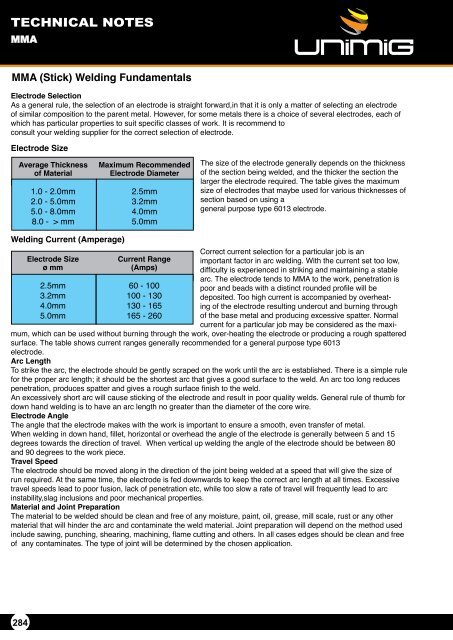Create successful ePaper yourself
Turn your PDF publications into a flip-book with our unique Google optimized e-Paper software.
TECHNICAL NOTES<br />
MMA<br />
MMA (Stick) Welding Fundamentals<br />
Electrode Selection<br />
As a general rule, the selection of an electrode is straight forward,in that it is only a matter of selecting an electrode<br />
of similar composition to the parent metal. However, for some metals there is a choice of several electrodes, each of<br />
which has particular properties to suit specific classes of work. It is recommend to<br />
consult your welding supplier for the correct selection of electrode.<br />
Electrode Size<br />
Average Thickness<br />
of Material<br />
Maximum Recommended<br />
Electrode Diameter<br />
1.0 - 2.0mm 2.5mm<br />
2.0 - 5.0mm 3.2mm<br />
5.0 - 8.0mm 4.0mm<br />
8.0 - > mm 5.0mm<br />
The size of the electrode generally depends on the thickness<br />
of the section being welded, and the thicker the section the<br />
larger the electrode required. The table gives the maximum<br />
size of electrodes that maybe used for various thicknesses of<br />
section based on using a<br />
general purpose type 6013 electrode.<br />
Welding Current (Amperage)<br />
Electrode Size<br />
ø mm<br />
Current Range<br />
(Amps)<br />
2.5mm 60 - 100<br />
3.2mm 100 - 130<br />
4.0mm 130 - 165<br />
5.0mm 165 - 260<br />
Correct current selection for a particular job is an<br />
important factor in arc welding. With the current set too <strong>low</strong>,<br />
difficulty is experienced in striking and maintaining a stable<br />
arc. The electrode tends to MMA to the work, penetration is<br />
poor and beads with a distinct rounded profile will be<br />
deposited. Too high current is accompanied by overheating<br />
of the electrode <strong>res</strong>ulting undercut and burning through<br />
of the base metal and producing excessive spatter. Normal<br />
current for a particular job may be considered as the maximum,<br />
which can be used without burning through the work, over-heating the electrode or producing a rough spattered<br />
surface. The table shows current ranges generally recommended for a general purpose type 6013<br />
electrode.<br />
Arc Length<br />
To strike the arc, the electrode should be gently scraped on the work until the arc is established. There is a simple rule<br />
for the proper arc length; it should be the shortest arc that gives a good surface to the weld. An arc too long reduces<br />
penetration, produces spatter and gives a rough surface finish to the weld.<br />
An excessively short arc will cause sticking of the electrode and <strong>res</strong>ult in poor quality welds. General rule of thumb for<br />
down hand welding is to have an arc length no greater than the diameter of the core wire.<br />
Electrode Angle<br />
The angle that the electrode makes with the work is important to ensure a smooth, even transfer of metal.<br />
When welding in down hand, fillet, horizontal or overhead the angle of the electrode is generally between 5 and 15<br />
degrees towards the direction of travel. When vertical up welding the angle of the electrode should be between 80<br />
and 90 degrees to the work piece.<br />
Travel Speed<br />
The electrode should be moved along in the direction of the joint being welded at a speed that will give the size of<br />
run required. At the same time, the electrode is fed downwards to keep the correct arc length at all times. Excessive<br />
travel speeds lead to poor fusion, lack of penetration etc, while too s<strong>low</strong> a rate of travel will frequently lead to arc<br />
instability,slag inclusions and poor mechanical properties.<br />
Material and Joint Preparation<br />
The material to be welded should be clean and free of any moisture, paint, oil, grease, mill scale, rust or any other<br />
material that will hinder the arc and contaminate the weld material. Joint preparation will depend on the method used<br />
include sawing, punching, shearing, machining, flame cutting and others. In all cases edges should be clean and free<br />
of any contaminates. The type of joint will be determined by the chosen application.<br />
284


